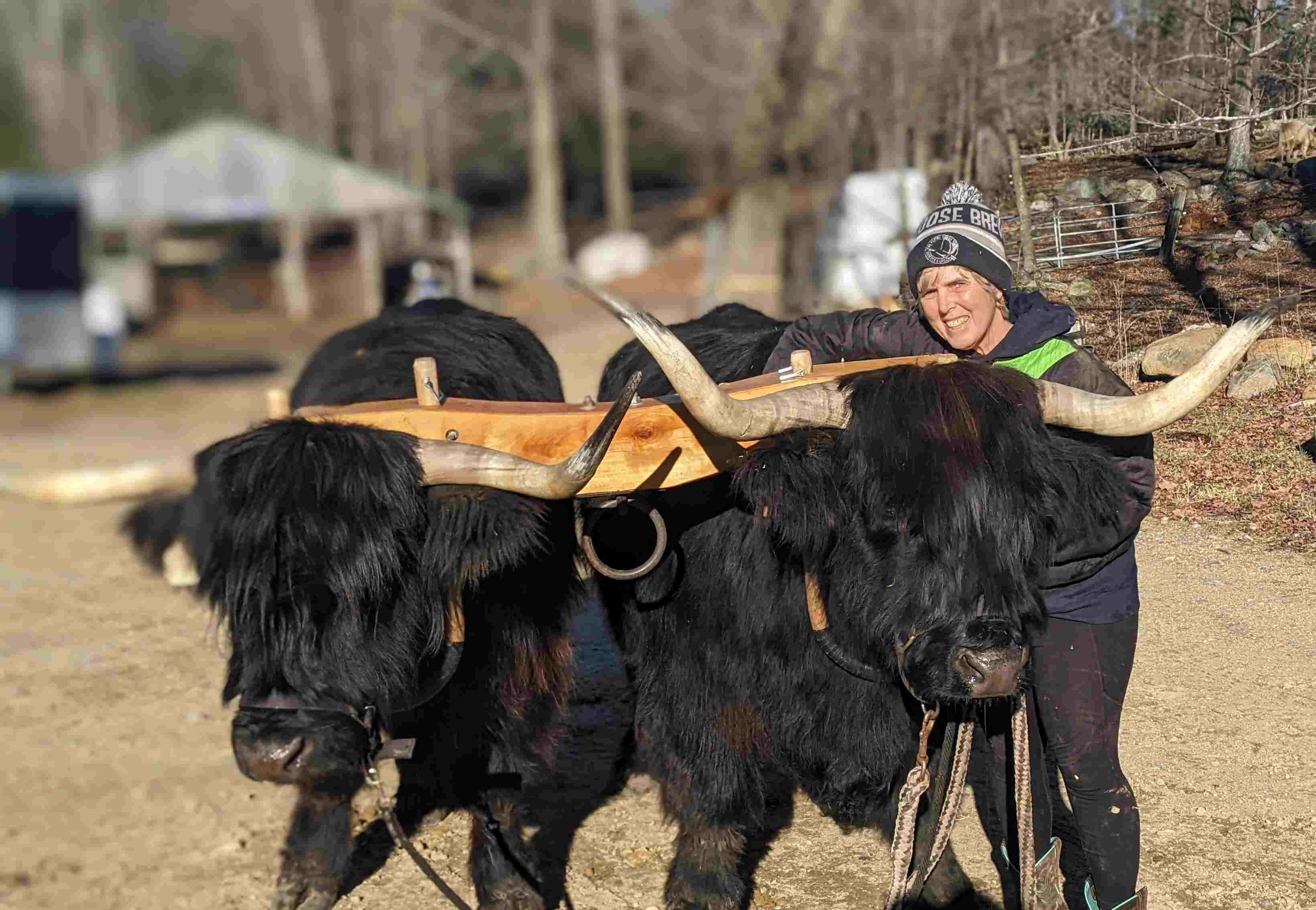An Instructive Step Back In Time With Oxen
posted on
May 26, 2024
Carole and her new working steer pair, Pop and Corn, were at Sanborn Mills Farm for a two-day intensive oxen training workshop with Farm Manager Ray Ramsey. Pop and Corn are Devon/Jersey crosses born on Martha's Vineyard. The water-powered sawmill is in the background on the left, and the grist mill on the right. Sanborn Mills Chef Kelly provided a fantastic lunch in the dining room in the barn on the hillside.

Coach Carole's Words of Wisdom: Failure is not a roadblock to success. Failure is the pathway to success.
Back in the day, oxen and horses were the tractors for farmers. Teams were used to plow the fields, pull mowers to cut hay, and pull cultivators to clear weeds from the gardens. After farm work, they became the engines to pull wagons to haul produce to market or take the family to church. Horses and oxen were the "horsepower" of the day and were so common we still use the words horsepower or hp to rate the power of automobiles.
If a vehicle is 200 hp, it would take 200 horses to produce the same power as its engine. Interesting. If you didn't have an engine to power your car, where would you keep 200 horses? Not in the garage, feeding that many beasts would also be way more expensive than buying fuel. Of course, if you have a garden, you'd have lots of fertilizer.
Ox Power?
Horsepower is the standard, but a single ox can pull more weight than a horse. If a horse and ox were the same size, it would take 157 oxen to pull the same weight as 200 horses. So, horsepower is the standard, and oxen have been mostly forgotten. But not by me and some others.
I have horses, but I find working with oxen more fun (and affordable), so last year, I purchased a pair of steers and two Deven/Jersey crosses named Pop and Corn. Even though I've trained and shown my Scottish Highland oxen for 12 years, I knew these two young steers would be a handful and needed help. Fortunately, I live in Loudon, not far from Sanborn Mills Farm.
Sanborn Mills
A century and more ago, Sanborn Mills Farm provided lumber, grain, and a meeting place for the community. Today, the farm brings instructors, farmers, and historians to teach people about old-fashioned ways. Workshops include blacksmithing, basket and bowl making, and gardening.
The Sanborn Mills Farm workshop that attracted my attention was Draft Animal and Oxen training with Farm Manager Ray Ramsey.
Ray uses oxen for all the gardening, fieldwork, and logging at Sanborn Mills Farm. He was the instructor for the class, and lucky for me, I was the only student in his two-day workshop. I wasn't alone because I brought Pop and Corn (who work as a team) and a Scottish Highland steer named Owen B.
A Single Ox
Owen B. had no partner, so he worked alone in a yoke and harness. Single steers are less powerful than a team but are more handy when cultivating (weeding) a garden. A single steer can work in narrow garden rows without trampling crops. A team provides double the power to plow fresh ground where corn and peas haven't yet been planted.
I'd never worked a single steer, but under Ray's guidance, we adjusted Owen's harness and took off down the road, pulling a lightweight log cone. The log cone fits over the stump of a cut tree and, when attached to a log, helps guide the log over rough ground. When I asked, Owen walked forward, stopped, and turned like he'd done it his whole life. That day, the log cone was empty, but soon, Owen will pull small logs or brush and eventually pull a cultivator to help me weed the flower garden.
Pop and Corn Get Retrained
Working with Owen was easy, but Pop and Corn were a challenge. They'd been previously trained by Cicilio, a Brazilian farmer who lives on Martha's Vineyard, where I bought the pair. Cicilio trained them well, but they had to learn to work with me. For instance, Cicilio drove the team from behind, and I wanted them to walk beside me. Both methods are effective, just different.
The first day was a wreck. Pop and Corn weren't used to me walking beside them and often backed up to try to get away. By the second day, with Ray's patient instruction, we worked together as a team (Pop and Corn) and teamster (me). Ray showed me how to direct them to pull an empty stone boat (a sled used to haul stones) through a simple obstacle course without knocking down any cones. Success.
More Work Ahead
Of course, our work isn't done. Ray told me I had to work with the "boys" daily to reinforce my commands and bond with them. And that's what I'll have to do because I just signed up for another Oxen workshop!
Stop by the farm to meet Pop, Corn, and Owen B. If they're not training with me, they'll be in the paddock looking for love and treats. You can visit during store hours, Friday and Saturday, between 10 a.m. and 4 p.m.
* * *
Carole Soule is co-owner of Miles Smith Farm, where she raises and sells beef, pork, eggs, and other local products. She can be reached at carole@soulecoaching.com. Carole also coaches humans, helping them feel better.



